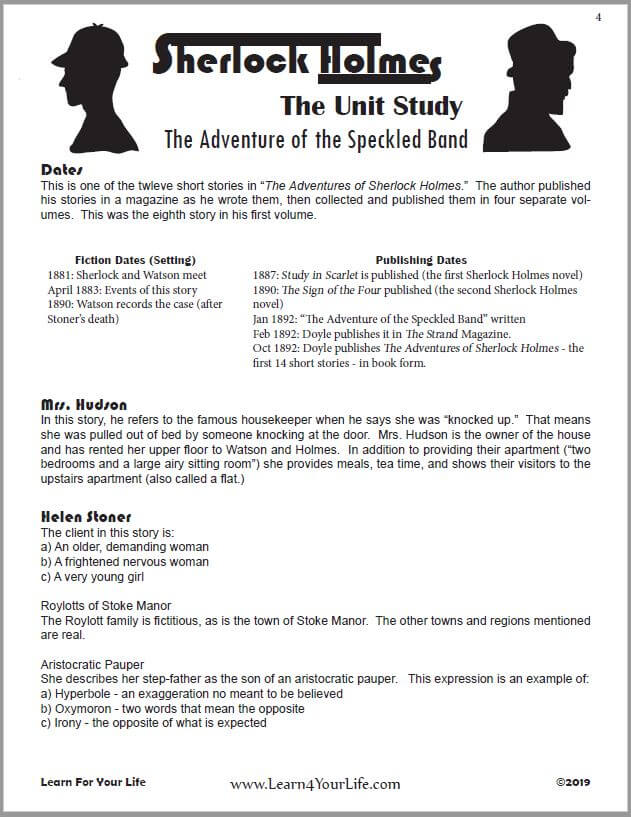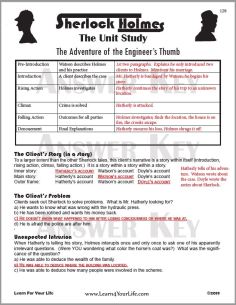Adventure of the Speckled Band Analysis
Discover the features hidden in 'Adventures of the Speckled Band' that make this one of Arthur Conan Doyle's most famous short stories.
What's on this page:
- What makes this story the most popular short story of the Sherlock Holmes cannon?
- Effect of Watson's perspective (First person secondary)
- Flaws in the narrative
What Makes The Adventure of the Speckled Band the Most Popular of the Sherlock short stories?
Note: In our Sherlock Holmes Unit Study this question can be addressed as a debate, as an essay, or as a literary hunt.There are, of course, many Sherlock fans who start with The Study in Scarlet and read all the way through the series of fifty-four short stories and four novelettes. But for many readers, The Adventure of the Speckled Band is the first - and maybe even only - Sherlock tale to be read. What makes it so popular?

Suspense
Suspense is building all the way through the story. We definitely would have some scary music playing in a movie. But how did Doyle communicate suspense with just his tool-kit of literary techniques?Foreshadowing is used throughout the story. A literary hunt will give you all these examples of foreshadowing:
- Holme's deduction that any woman traveling that early in the day must have something pressing.
- Helen is trembling when he meets her.
- Holmes asks Watson to bring a pistol. (Aside note: one would think by this time Watson would always do so. But that wouldn't add to the suspense, would it?)
- The motif of the whistle in the night and the clanging metalic sound. You just know that can't be good.
- Watson writes several times that Holmes was more pale or more grim than he had ever seen him.
- Holmes worries that is too dangerous for Watson to come. (Meanwhile, Watson is utterly clueless.)
- Sitting still and silent in a dark room next to a murderer ready to strike again, the clueless Watson has his pistol drawn and waiting - but for what?
Can you think of a better short story for building suspense than this?
Mystery
"Mysteries" and "detective stories" are considered synonyms by some; others consider detective stories a sub-genre of mysteries. Others see them as different genres but with blurred edges.No matter how one categorizes it, The Adventure of the Speckled Band is both.
While detective stories often have detectives on the hunt for the cause of the (most likely) crime, mysteries don't always require a detective or even a crime. Some of the characteristics that are frequently unique to mysteries include:
- A length of time between the event and the story (the longer the more mysterious)
- An eerie setting
- A somber tone
What qualities of this story are mysterious?
- An old (albeit its only two years old) unsolved crime
- A dark mansion in disrepair
- Noises in the night
- Strange animals and guests inside and out
Justice
Of course the whole point of a detective story is to discover the criminal and see that appropriate justice is served. But, really, when you are writing fifty-four short detective stories you can't have the criminal hand-cuff and led away by Scotland Yard every single time.So, Doyle needed a little variety in his endings. And here the speckled band provides a unique ending as the perpetrator becomes his own victim. Sherlock was quite cheerful about his own role in contributing to the death of another, but the reader and detective alike can enjoy the satisfaction of a just ending.
Point of View

First Person - Secondary
Sherlock Holmes is one of the first examples of first person-secondary point of view. First person perspective occurs when there is a narrator using the word “I” and “we.” That narrator is Watson. But he is not the main character; Sherlock is the main character. Since Watson is a secondary character, this is first person secondary.What is the value of having Watson tell the story?
It adds to the suspense of the story. The reader and Watson know that Holmes is on to something, but both have to wait to find out. In reality, Holmes would likely have told his partner and friend his theory while they were waiting. But not-knowing adds to the suspense of the rising action.
Flaws in the Story
No doubt, The Adventure of the Speckled Band IS a great story. But it isn't perfect; it does contain some flaws.Swamp Adder of India
An adder is a poisonous snake. There is no known “swamp adder of India” though there is a swamp adder in Mozambique which is not yellow-speckled. Much attention has been given to identify if there is a particular snake that meets this description but it would appear that Doyle simply made the name up. Other unrealistic features include:- Snakes don’t climb ropes.
- Snakes can’t hear whistles as they don’t have ears.
- Snakes couldn’t live in a sealed iron safe.
- A man as large as Roylott would not be killed instantly by virtually any snake venom.

“And there reared itself from among his hair the squat diamond-shaped head and puffed neck of a loathesome serpent.”
Watson In The Dark
It really wouldn't make much sense for Holmes to NOT tell Watson what his suspicions were before their long sojourn in the dark. They had plenty of time to talk at the Crown Inn and on their way over. It would make some sense for Sherlock to key him in, "Hey, I'm kind of thinking there might be a poisonous snake slithering down that rope."Watson was supposed to sit in the dark with his pistol ready to shoot - what? It would make their partnership a little more of a partnership if he had some idea of what he might be aiming at.
But then again, that would mess up the first person - secondary point of view we discussed above and ruin the detective story. That was, afterall, the whole point.
Date of The Adventure of the Speckled Band
Dates of The Fictitious Events (Setting)
- 1881 - Holmes and Watson meet
- 1883 - Events of this story
- 1890 - Watson pens the details of the case (after the death of Helen Stoner presumably from the first paragraph)
Publishing Dates of The Story
- 1887: Study in Scarlet is published (the first Sherlock Holmes novel)
- 1980: The Sign of the Four is published (the second Sherlock Holmes novel)
- Jan 1892: Doyle writes The Adventure of the Speckled Band.
- Feb 1892: Doyle publishes it in the Strand Magazine. (He published his shoft stories in magazines one by one as he wrote them).
- Oct 1892: Doyle publishes "The Adventures of Sherlock Holmes."
Other Information in "Sherlock Holmes: The Unit Study"
Background information on the beginning of the Holmes/Watson partnership is listed.Reading comprehension questions provided.
Locked Room mysteries described.
List of clues and red herrings (and background information on the phrase "red herring".)
More Activities:
- Read as a play (links to original play and a more modern version)
- Develop their own Locked Room Mystery
- Make a shoe-box scene based on their Locked Room scenario
- Field trip idea: An escape room
Buy Sherlock Holmes: The Unit Study


Student Guide AND Teacher's Answer Key Included
$2.99 Download - 183 pages
Eight of the most popular tales demonstrate how to investigate a detective story.
![]()
Sherlock Holmes Pages
A catalog of our pages on Sherlock Holmes.


About Our Site
Hands-On Learning































